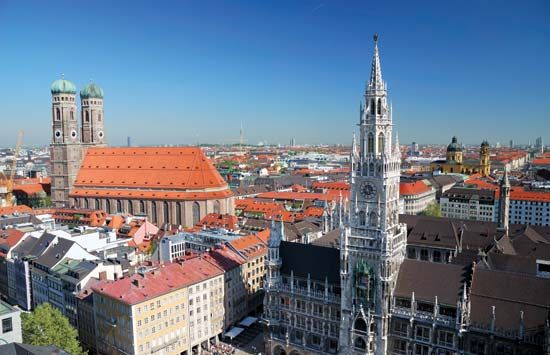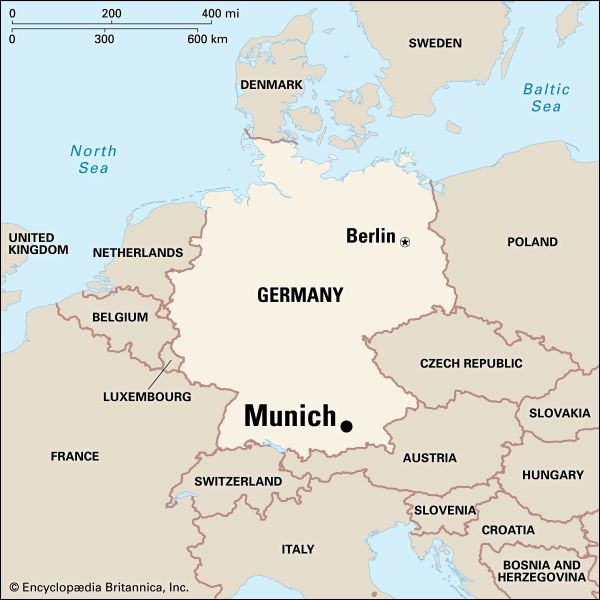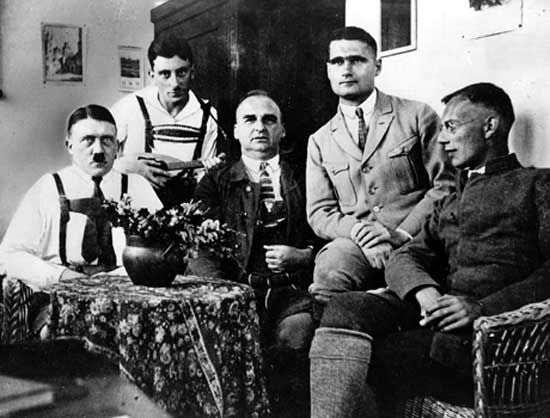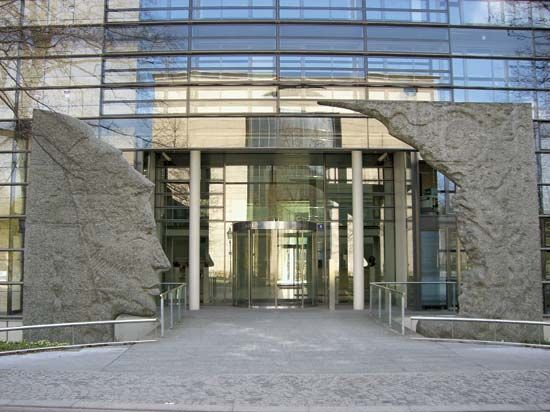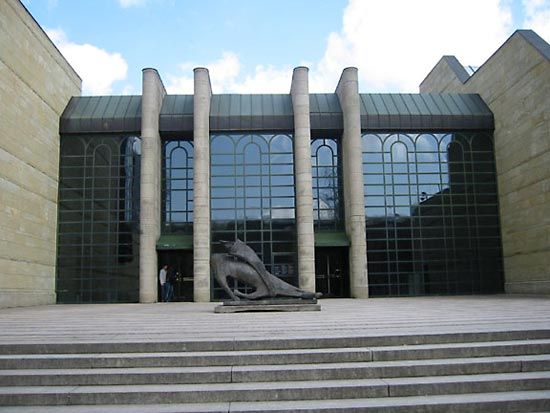Munich
Our editors will review what you’ve submitted and determine whether to revise the article.
- German:
- München
Where is Munich located?
What is Munich called in Germany?
What are the major museums and art galleries of Munich?
What famous festival is celebrated in Munich?
News •
Munich, city, capital of Bavaria Land (state), southern Germany. It is Bavaria’s largest city and the third largest city in Germany (after Berlin and Hamburg). Munich, by far the largest city in southern Germany, lies about 30 miles (50 km) north of the edge of the Alps and along the Isar River, which flows through the middle of the city. Pop. (2011) 1,348,335; (2021 est.) 1,487,708.
History
Munich, or München (“Home of the Monks”), traces its origins to the Benedictine monastery at Tegernsee, which was probably founded in 750 ce. In 1157 Henry the Lion, duke of Bavaria, granted the monks the right to establish a market where the road from Salzburg met the Isar River. A bridge was built across the Isar the following year, and the marketplace was fortified.
In 1255 Munich became the home of the Wittelsbach family, which had succeeded to the duchy of Bavaria in 1180. For more than 700 years the Wittelsbachs would be closely connected with the town’s destiny. In the early 14th century the first of the Wittelsbach line of Holy Roman emperors, Louis IV (Louis the Bavarian), expanded the town to the size at which it remained up to the end of the 18th century. Under the Bavarian elector Maximilian I (1597–1651), a powerful and effective ruler, Munich increased in wealth and size and prospered until the Thirty Years’ War. It was occupied by the Swedes under Gustav II Adolf (Gustavus Adolphus) in 1632, and in 1634 a plague epidemic resulted in the death of about one-third of its population.
The third Wittelsbach who left his mark on the community was Louis I, king of Bavaria from 1825 to 1848. Louis planned and created modern Munich, and his architects established the city’s characteristic appearance in the public buildings they designed. The 19th century was Munich’s greatest period of growth and development. Protestants became citizens for the first time in what had been until then a purely Roman Catholic town. The city’s population of 100,000 in 1854 grew to 500,000 by 1900. Munich’s cultural importance in Europe was enhanced when Louis II, by his championing of the composer Richard Wagner, revived its fame as a city of music and the stage.
The rule of the Wittelsbach dynasty finally ended with the self-imposed exile of Louis III in November 1918, and, in the aftermath of World War I, Munich became a hotbed of right-wing political ferment. It was in Munich that Adolf Hitler joined the Nazi Party and became its leader. The beer cellar where he held meetings that led to the Beer Hall Putsch (“rising”) against the Bavarian authorities in November 1923 can still be seen. In World War II Munich suffered heavily from Allied bombing raids, which destroyed more than 40 percent of its buildings.
The contemporary city
In the past Munich suffered economically because of its distance from seaports and from the coal mines of the Ruhr region. But this situation improved when fuels other than coal came into general use. Munich shifted from heavy to light industry, to the manufacture, for example, of precision instruments, optical and electrical appliances, and aerospace and other high-technology products, as well as to the production of food, cosmetics, and clothing. The city has several of the largest breweries in Germany and is famous for its beer and its annual Oktoberfest celebration. Munich is a major tourist destination and a convention centre. Book publishing and printing and television production are also important. The city is a centre of the banking and financial industry, and it has one of the largest wholesale markets in Europe for fruit, vegetables, and animal produce.
Munich is connected by rail to all the main cities of Germany and Austria, and it is a major hub for the German and European high-speed passenger rail system. Autobahnen (expressways) from Stuttgart, Nürnberg, and Salzburg converge on the city. Franz Josef Strauss Airport, located 17 miles (27 km) northeast of Munich, opened in 1992. A modern subway has been built in the city.
The old town, clustered around the ancient crossroads of the marketplace in the Marienplatz, has increasingly become a business centre and has lost much of its ancient character. Among the old buildings that still stand are three of the seven town gates—Karls, Sendlinger, and Isar, all dating from the 14th century. Other medieval buildings include Munich’s cathedral, the Frauenkirche (Church of Our Lady; built 1468–88), whose massive cupola-capped towers are conspicuous landmarks; and the Old Town Hall (1470–80) in the Marienplatz. Nearby is Peterskirche (1169), Munich’s oldest church, which was completely destroyed in World War II but subsequently rebuilt in its original form. The former arsenal of the town at Jakobsplatz is now the municipal museum.
The oldest of the Wittelsbach residences, the Old Court, has retained its medieval appearance. The present Residence dates from the 16th century, but the style of every period up to the 19th century was tried out on it with superb effect; the building was destroyed in World War II but has been reconstructed. Another survival from this early period is Michaelskirche (1583–97), which is considered to be the most important Renaissance church in Germany and one of the most beautiful in central Europe.
Despite these older buildings, the old town is predominantly Baroque and Rococo. Italian models inspired the late 17th-century Theatinerkirche (Theatine Church), the early 18th-century Dreifaltigkeitskirche (Trinity Church), and an 18th-century Marianist church, the Bürgersaal. Michaelskirche at Berg am Laim, the Asamkirche (also called St. John of Nepomuk Church), and the Cuvilliés Theatre at the Residence were completed between 1746 and 1777. The last-named structure, a magnificent Rococo theatre built for the Wittelsbach court, was destroyed in World War II, but much of its interior decoration was saved, and the theatre was reconstructed. Among the summer castles built outside the town walls are Schleissheim and Nymphenburg. The latter’s hunting lodge, the Amalienburg Pavilion, is a Rococo masterpiece. Several palaces built by the Bavarian landed gentry and court nobility at the same time also survive. The New Town Hall (built 1867–74) was enlarged at the beginning of the 20th century.
Munich received the first great impetus to expand beyond the old town from the magnificent building program undertaken by Louis I in the 19th century. Between the Victory Gate and the Hall of Generals, he had the monumental Ludwigstrasse built, along which he constructed the state library, the Ludwigskirche, and the University of Munich. Other projects commissioned by Louis were the Königsplatz with the Glyptothek (“Sculpture Gallery”), a museum that houses a collection of ancient and modern sculpture; the Propyläen, a magnificent gateway in the style of the Propylaea at Athens; and the Alte (Old) Pinakothek, which contains one of Europe’s great collections of paintings. Louis’s son Maximilian II (reigned 1848–64) built the broad Maximilienstrasse and the Maximilianeum, which now houses the Bavarian parliament (Landtag).
The University of Munich was moved from Landshut to Munich in 1826 by Louis I. Among the city’s other important educational establishments are the Technical University of Munich (founded 1868) and academies of art, music, philosophy, military studies, and film and television. Munich is also home to the headquarters of the Max Planck Society for the Advancement of Science, Germany’s official scientific research organization.
Munich has long been a centre for the arts. Music, especially opera, has flourished. In addition to the Bavarian State Opera Company and the Munich Philharmonic and other orchestras, there are the Bavarian State Dramatic Company and numerous private theatres. Important libraries include the Bavarian State Library and the University Library.
Munich has some outstanding museums and art galleries. The Alte Pinakothek, part of the Bavarian State Picture Galleries, houses the art treasures accumulated by the Wittelsbach family since the 16th century. Its collections of Renaissance-era German and Dutch paintings and Flemish Baroque paintings are especially strong, with many masterpieces by Albrecht Dürer, Peter Paul Rubens, and Anthony van Dyck. In addition to the Alte Pinakothek and the Glyptothek, there are the Neue (New) Pinakothek, which houses Munich’s main collection of 19th- and 20th-century art; the Bavarian National Museum, which contains German art and applied art since the Middle Ages; and the Residence Museum, which has paintings, sculpture, furniture, and ceramics. The Deutsches Museum, on an island in the Isar River, is a huge and comprehensive museum of science, engineering, and technology with a notable library. There are also the State Gallery of Modern Art and numerous small art galleries. In 1972 the city hosted the Olympic Summer Games. Those games would be forever associated with an attack by Palestinian terrorists that claimed the lives of 11 Israeli athletes.
The Editors of Encyclopaedia Britannica
